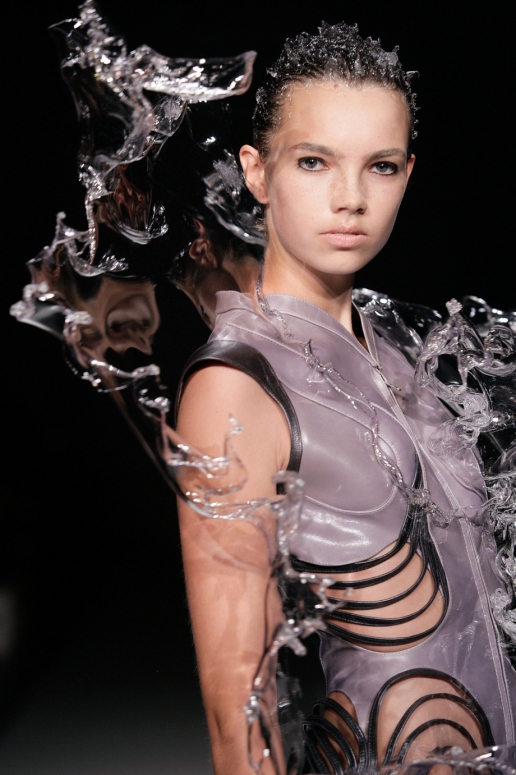
Gallery of stars
Polymers are a first rate high-tech material, but also have a “luxury” connotation. Manufacturers are no longer ashamed to be associated with them; indeed, they are beginning to talk openly about their amazing qualities. Plastics are now considered as a material in their own right. Not a last resort or ersatz, not commoners in a country of noble materials…Their remarkable performances whet the imagination of renowned designers who are eager to use them to enhance their works. And when they are combined with the best specialist plastics engineers, the result is very near to perfection.
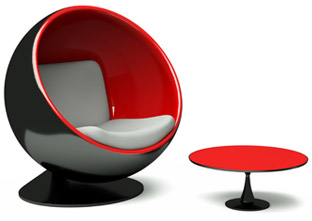
The cult of plastic !

In the 1950s and 1960s, some designers were breaking new ground in their work with plastic materials. Verner Panton’s famous S chair, Saarinen’s Globe armchair or even the Teleavia television designed by Roger Talon would soon become design icons. For a long time, reserved for an avant-garde, not to say financially privileged elite, these objects would take pride of place in living rooms. An on-going trend encompassing modern products which may well become cult figures themselves in the years to come; items such as the Dyson vacuum cleaner or even some coffee makers and food processors.
Praise, where praise is due
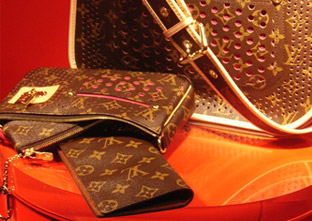
We have all heard of the luxury leather goods label famous for its brown and beige trunks marked with the initials of the founder, LV. A lesser known fact is that most of its production is in plastic. The famous wallets are actually made from a material that the marketing department has christened “monogram canvas in polyvinyl chloride”, a material better known by the initials PVC. But is there anything wrong with that? The added value of the brand owes more to the originality of its designs, the care with which the products are assembled and, of course, the image it conveys.
The same goes for another luxury icon renowned for the manufacture of its pens. In the catalogue of this “White Star” brand, you will find that the body of the pen is made from “precious resin”. A resin that is in fact Bakelite which, when polished, sparkles with the lights of a thousand little fires, on account of its reflective qualities.
Kartell, the magic of plastic
Plastics are also using furniture as a means of entering the world of luxury. Their infinite moulding possibilities undoubtedly count for a lot in that regard, but in the 1960s Haute couture, luxury jewellery, fashion, etc. still looked down on these synthetic materials! That did not prevent some bold designers from gradually bringing polymers to the fore. A leading figure in this movement was the Italian, Giulo Castelli, founder of the furniture design company Kartell. He insisted on plastic! He was undoubtedly avant-garde in his approach, but he was also passionate about technological innovation. From the word go, he approached manufacturers in the plastics industry and asked them to find new materials suited to the mass production of furniture.
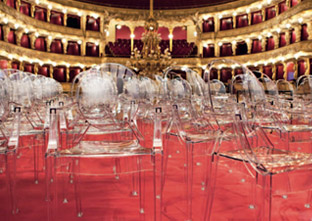
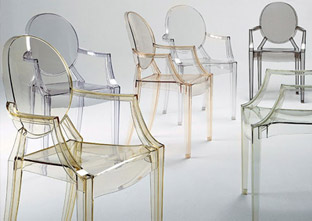 The manufacturers, always keen to explore new openings, went along with him. Given their subsequent success, that decision was definitely a good one! Design pioneer and improved manufacturing technology: an explosive combination!
The manufacturers, always keen to explore new openings, went along with him. Given their subsequent success, that decision was definitely a good one! Design pioneer and improved manufacturing technology: an explosive combination!
Kartell is still at the forefront of all that is best in the field. The first translucent plastic chairs, the first sofa in technical plastic, gas injection, laser welding for shells – all thanks to Kartell! Recognised all over the world, this company is one of the very few to be granted the honour of an exhibition at the prestigious Museum of Modern Art in New York. For many designers, being taken on by Kartell is considered to be recognition of their work.
And now for haute couture !

Paco Rabanne is no longer so alone! Born in an era when plastics were commonplace and mainly trained in schools that value the benefits of synthetic fibres, the new generation of designers do not hesitate to use them. The leaders of this movement, that some call conceptual fashion, are two Japanese nationals, Rie Hosokai and Tasashi Kawada, and a Dutch lady called Iris Van Herpen. The first two design dresses using just two materials, air and a little plastic, which gives their creations a mind-blowing lightness, full of elegance, grace and delicacy. The young lady from the Netherlands claims to draw her inspiration from the human body and its complex network of blood vessels. Her garments are extremely complex and only plastics can satisfy her creativity.
Her creations have won over artistes with extravagant personalities, like Bjork and Lady Gaga, who have been quick to offer a helping hand by taking part in fashion shows. Knowing as we do how short the road is from Haute couture to ready-to-wear, it’s a fair bet that it will not be long before ranges of these dresses appear in the ready-to-wear chains.
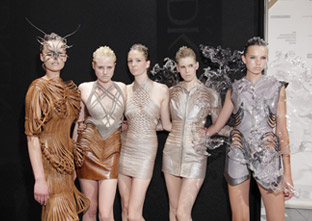
A long way from la medusa and jelly shoes
 In the meantime the luxury ready-to-wear sector, show manufacturers like Melissa in Brazil managed to generate a passion for their shoes. Ballet shoes, heels, Spartiates, they are all made from PVC! And not just any old PVC, as it is recycled and…recyclable. But, although we are not really talking about luxury as such, designers such as Thierry Mugler, Jean-Paul Gaulthier or even the amazing British designer Vivienne Westwood have designed a number of models for the brand.
In the meantime the luxury ready-to-wear sector, show manufacturers like Melissa in Brazil managed to generate a passion for their shoes. Ballet shoes, heels, Spartiates, they are all made from PVC! And not just any old PVC, as it is recycled and…recyclable. But, although we are not really talking about luxury as such, designers such as Thierry Mugler, Jean-Paul Gaulthier or even the amazing British designer Vivienne Westwood have designed a number of models for the brand.
Melissa knew that it had to distance itself from the not-always-attractive image of PVC by using its capacity to take on any shape or colour. There is even a strawberry scented model composed of microcapsules incorporated directly into the material.
All of which goes to show that the important thing is to dare to avoid received ideas or assumptions. Would this be in keeping with the times? The new designers will be quick to tell us so, especially as many materials put forward by the plastics industry are simply waiting for new applications to be found.





